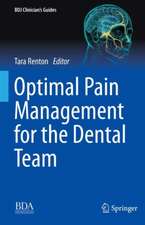3D Imaging in Endodontics: A New Era in Diagnosis and Treatment
Editat de Mohamed I. Fayad, Bradford R. Johnsonen Limba Engleză Hardback – 27 iul 2023
The ability to obtain an accurate 3D representation of a tooth and the surrounding structures by means of noninvasive CBCT imaging is changing the approach to clinical decision making in endodontics. Clinicians long accustomed to working in very small, three-dimensional spaces are no longer constrained by the limitations of two-dimensional imaging. The challenges of mastering the new technology can, however, be daunting. The detailed guidance contained in this book will help endodontists to take full advantage of the important benefits offered by CBCT.
Preț: 1043.61 lei
Preț vechi: 1098.53 lei
-5% Nou
Puncte Express: 1565
Preț estimativ în valută:
199.69€ • 208.51$ • 164.90£
199.69€ • 208.51$ • 164.90£
Carte disponibilă
Livrare economică 25 martie-08 aprilie
Preluare comenzi: 021 569.72.76
Specificații
ISBN-13: 9783031327544
ISBN-10: 3031327543
Pagini: 339
Ilustrații: VI, 339 p. 224 illus., 182 illus. in color.
Dimensiuni: 155 x 235 mm
Greutate: 0.73 kg
Ediția:2nd ed. 2023
Editura: Springer International Publishing
Colecția Springer
Locul publicării:Cham, Switzerland
ISBN-10: 3031327543
Pagini: 339
Ilustrații: VI, 339 p. 224 illus., 182 illus. in color.
Dimensiuni: 155 x 235 mm
Greutate: 0.73 kg
Ediția:2nd ed. 2023
Editura: Springer International Publishing
Colecția Springer
Locul publicării:Cham, Switzerland
Cuprins
Chapter 1. Principles of Cone Beam Computed Tomography.- Chapter 2. New software for endodontic diagnosis and treatment: the e-Vol DXS.- Chapter 3. Utilization of Cone Beam Computed Tomography in Endodontic Diagnosis.- Chapter 4. The Impact of Cone Beam Computed Tomography in Non-surgical and Surgical Treatment Planning.- Chapter 5. Three-Dimensional Evaluation of Internal Tooth Anatomy.- Chapter 6. Non-Surgical Retreatment Utilizing Cone Beam Computed Tomography.- Chapter 7. Surgical Treatment Utilizing Cone Beam Computed Tomography.- Chapter 8. The use of Cone Beam Computed Tomography in Piezosurgery and Static Navigation (PRESS) .- Chapter 9. The use of cone beam computed tomography in dynamic navigation.- Chapter 10. Utilization of Cone beam Computed Tomography in diagnosis and treatment of traumatic injuries .- Chapter 11. Root Resorption .
Notă biografică
Mohamed I. Fayad, BDS, MS, PhD, received his DDS in 1985 from the College of Dentistry, Cairo University. Dr. Fayad received his Masters in Oral Sciences in 1994 from the University at Buffalo School of Dental Medicine (New York). He received his PhD in 1996 as a joint supervision between University at Buffalo and Cairo University. He received his Endodontics training at the University of Illinois Chicago (UIC) College of Dentistry. Currently he is Director of Endodontic Research, and a Clinical Associate Professor in the Endodontics Department of the UIC College of Dentistry, dividing his time between teaching, research, intra-and extra-mural continuing education and private practice.
He currently serves on the Scientific Advisory and Manuscript Review Panel of the Journal of Endodontics. He served on the American Association of Endodontists (AAE) Research and Scientific Affairs Committee and co-chaired the AAE/AAOMR committee that drafted the Joint Position Statement on use of CBCT in endodontics (2015). He has numerous publications and chapters in peer reviewed journals and textbooks (Pathways of the Pulp, Contemporary Surgical Endodontics, and Endodontics Principles and Practice). He is the co-editor of the CBCT textbook (3-D Imaging in Endodontics: A New Era in Diagnosis and Treatment) by Springer (2016). He is a recipient of the Calvin D. Torneck Part-Time Educator Award for 2022 by the American Association of Endodontists. He is a Diplomate of the American Board of Endodontics and has given numerous presentations nationally and internationally.
Bradford R. Johnson, DDS, MHPE, completed his undergraduate education at the University of Colorado, received his DDS degree from Virginia Commonwealth University, and Endodontics specialty training at the University of Illinois Chicago (UIC) where is currently a tenured Professor, Department of Endodontics, Department Head and Postgraduate Program Director. He is a Diplomate of the American Board of Endodontics and received a Master of Health Professions Education (MHPE) degree from the UIC College of Medicine in 2005.
Dr. Johnson is a past-president of the Illinois Association of Endodontists and completed a 3-year term on the Board of Directors of the American Association of Endodontists in 2018. He was also a Commissioner, Commission on Dental Accreditation (CODA; 2016-20) and is a Director and current President of the American Board of Endodontics (2023-24). In addition to full-time teaching, he maintains a part-time clinical practice limited to endodontics. Dr. Johnson has published over 70 articles and abstracts in peer reviewed dental journals and is co-author of twelve textbook chapters.
He currently serves on the Scientific Advisory and Manuscript Review Panel of the Journal of Endodontics. He served on the American Association of Endodontists (AAE) Research and Scientific Affairs Committee and co-chaired the AAE/AAOMR committee that drafted the Joint Position Statement on use of CBCT in endodontics (2015). He has numerous publications and chapters in peer reviewed journals and textbooks (Pathways of the Pulp, Contemporary Surgical Endodontics, and Endodontics Principles and Practice). He is the co-editor of the CBCT textbook (3-D Imaging in Endodontics: A New Era in Diagnosis and Treatment) by Springer (2016). He is a recipient of the Calvin D. Torneck Part-Time Educator Award for 2022 by the American Association of Endodontists. He is a Diplomate of the American Board of Endodontics and has given numerous presentations nationally and internationally.
Bradford R. Johnson, DDS, MHPE, completed his undergraduate education at the University of Colorado, received his DDS degree from Virginia Commonwealth University, and Endodontics specialty training at the University of Illinois Chicago (UIC) where is currently a tenured Professor, Department of Endodontics, Department Head and Postgraduate Program Director. He is a Diplomate of the American Board of Endodontics and received a Master of Health Professions Education (MHPE) degree from the UIC College of Medicine in 2005.
Dr. Johnson is a past-president of the Illinois Association of Endodontists and completed a 3-year term on the Board of Directors of the American Association of Endodontists in 2018. He was also a Commissioner, Commission on Dental Accreditation (CODA; 2016-20) and is a Director and current President of the American Board of Endodontics (2023-24). In addition to full-time teaching, he maintains a part-time clinical practice limited to endodontics. Dr. Johnson has published over 70 articles and abstracts in peer reviewed dental journals and is co-author of twelve textbook chapters.
Textul de pe ultima copertă
This book, now in an extensively revised second edition, is designed to provide the reader with a full understanding of the role of cone beam computed tomography (CBCT) in helping to solve many of the most challenging problems in endodontics. It will shorten the learning curve in application of this exciting imaging technology in a variety of contexts: difficult diagnostic cases, treatment planning, evaluation of internal tooth anatomy prior to root canal therapy, nonsurgical and surgical treatments, early detection and treatment of resorptive defects, and outcomes assessment.
The ability to obtain an accurate 3D representation of a tooth and the surrounding structures by means of noninvasive CBCT imaging is changing the approach to clinical decision making in endodontics. Clinicians long accustomed to working in very small, three-dimensional spaces are no longer constrained by the limitations of two-dimensional imaging. The challenges of mastering the new technology can,however, be daunting. The detailed guidance contained in this book will help endodontists to take full advantage of the important benefits offered by CBCT.
The ability to obtain an accurate 3D representation of a tooth and the surrounding structures by means of noninvasive CBCT imaging is changing the approach to clinical decision making in endodontics. Clinicians long accustomed to working in very small, three-dimensional spaces are no longer constrained by the limitations of two-dimensional imaging. The challenges of mastering the new technology can,however, be daunting. The detailed guidance contained in this book will help endodontists to take full advantage of the important benefits offered by CBCT.
Caracteristici
Explains how CBCT can solve challenging problems in endodontics Shortens the learning curve in the use of CBCT Offers detailed guidance on image interpretation











